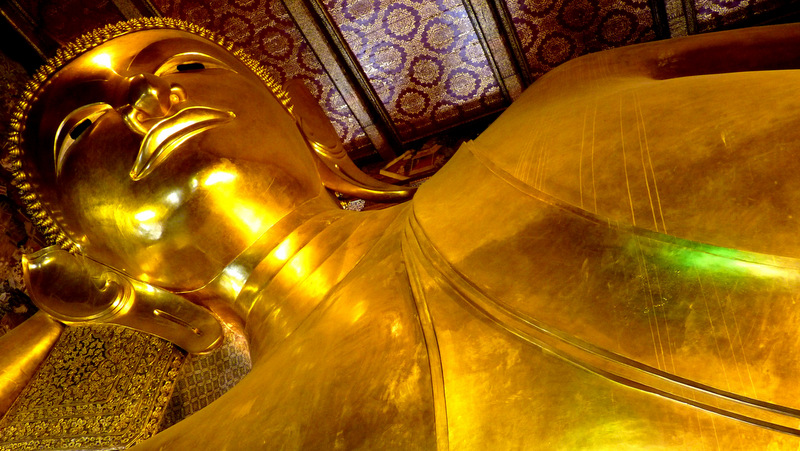Siddhartha Gautama of the Sakya clan, who was to become the Buddha, was born in a small Hindu kingdom neighbouring to Nepal. First he became an ascetic before reaching enlightenment. Afterwards, he taught the truths he had learned and hence gained many disciples. He died around the age of 80.
The Buddha put forward the four noble truths concerning man’s condition and the eightfold path that should lead to enlightenment, perfection, absence from rebirths and finally to nirvana which is to be understood as the extinction of the “three poisons”, namely passion, aversion and ignorance. When these poisons or “fires” are extinguished, freedom from the cycle of rebirth (samsara) is attained.
In the reclining posture, the Buddha is also referred to as being in the “sleeping lion’s” position which is the state in that the Buddha died. Buddha lies on the right side with knees slightly bend and the left hand on the thigh. In Buddhism, the sleeping lion posture is also the traditionally recommended mode for dying. A well-known Buddha image in this position is the reclining Buddha at Wat Pho in Bangkok.
For example, a walking Buddha is the Buddha Monthon (Phutthamonthon) which is created in the Sukhothai style. The image performs the abhaya mudra, the gesture of reassurance and dispelling fear. Characteristic of the period are the broad shoulders and pendant arm. The flat feet and projecting heels are part of the anatomy characteristic of a great being.
It is also important to note that there are Buddha statues for each day of the week, each in different pose. They are often lined up in a row at a temple. Many Thai people know the day and hour they were born thus paying respect to the Buddha image presiding over their day of birth.
The Buddha of Monday is the one preventing calamities. The image for Tuesday is in the reclining posture. Wednesday, in fact, has two Buddha images, in the morning it is the Buddha holding an alms bowl and in the evening he is in the posture of retreating in the forest. The Thursday image is meditating and on Friday the Buddha is in reflection. The Saturday statue is sitting in meditation while being protected by Muchalinda’s cobra hood. Finally, the Sunday Buddha is in pensive thought.
The most prevalent posture and gesture in Thailand is the Buddha in sitting position with his right hand pointing down to the earth. By doing so, he calls on the earth to be his witness that over many lives he fulfilled and accomplished himself thus being able to reach enlightenment.
Summing up, we may say that the Buddha image in Thai culture is very prominent and deeply revered.
Sirinya Pakditawan is a ‘luk kreung’, or half-Thai, born and raised in Hamburg, Germany. She enjoys writing about Thailand, with a focus is on culture, art, history, tradition and on the people, as well as a mix of topics concerning Thai popular culture, travelogues and articles about Thai food.
Sirinya’s aim is not only to entertain you but to provide you with information and facts about Thailand, its culture and history that may not be generally known, in particular to the Western world. She has a PhD in American Studies from the University of Hamburg.
To read the original story, and many more, be sure to check out Sirinya’s blog: www.sirinyas-thailand.de








